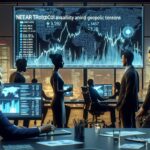In a groundbreaking move within the cryptocurrency and AI landscape, Compute Labs is collaborating with NexGen Cloud to launch a $1 million “public vault,” designed to democratize access to the substantial profits generated by industrial-grade GPUs. This collaboration marks a significant shift, as the power of AI infrastructure has largely been centralized in the hands of major players such as AWS and other venture capital-backed entities. By fractionalizing ownership of cutting-edge GPUs, such as the NVIDIA H200, Compute Labs is creating unique investment opportunities for everyday investors.
According to Compute Labs, this initiative allows token holders to earn stablecoin yields directly from active AI compute, eliminating the necessity to manage physical hardware or depend on high-priced public stocks. The firm specifies that the initial fundraising has successfully secured $1 million, with plans to acquire top-tier NVIDIA GPUs, which are essential for AI training and inference tasks. With projected yields potentially exceeding 30% annually based on GPU rental agreements, this venture aims to shake up the established norms of investment in AI infrastructure.
“When the data center is using the GPU owned by an investor, Compute Labs manages that through its protocol and balance sheet,”
explains Nikolay Filichkin, chief business officer at Compute Labs. This innovative structure allows individual investors to acquire fractions of high-value GPUs, effectively opening up the previously exclusive realm of enterprise AI infrastructure to a broader audience.
The funds generated by InfraHub, NexGen Cloud’s investment arm, will be utilized to purchase GPUs that will then be tokenized, enabling accessible investments starting from just a few hundred dollars. Additionally, the incorporation of NFTs distinguishes between various types of tokenized hardware investment, adding a new layer of complexity and uniqueness to the offerings.
With backing from notable entities such as Protocol Labs and OKX Ventures, Compute Labs operates under a straightforward 10% fee structure across its services. Youlian Tzanev, co-founder and chief strategy officer at NexGen Cloud, elaborates on the significance of this model, stating that it “assigns concrete, tradable value to each GPU cycle,” thus rationalizing the AI market by linking supply directly to demand and pricing.

Compute Labs and NexGen Cloud Partnership
Key points regarding the collaboration between Compute Labs and NexGen Cloud and its implications for investors:
- Partnership for Ownership Distribution: Compute Labs and NexGen Cloud are distributing ownership of a $1 million “public vault” comprising fractionalized yield-bearing tokens backed by industrial-grade GPUs.
- Access to High-Value Infrastructure: Investors can access the earning potential of high-value enterprise hardware (e.g., NVIDIA H200 GPUs worth around $30,000 each) without the need to manage the physical hardware.
- Stablecoin Yield Opportunity: The pilot project allows investors to earn stablecoin yield directly from live AI compute, potentially exceeding 30% per year, representing an innovative investment approach.
- Fractionalization of GPUs: The investment model fractionalizes expensive GPUs, enabling individual investors to buy shares for a few hundred dollars, democratizing access to AI infrastructure.
- Operational Management by Compute Labs: Compute Labs manages the GPUs leased to data centers, ensuring net revenue after costs returns to investors, creating a streamlined revenue process.
- Market Rationalization: The model sets a tradable value to each GPU cycle, linking supply and demand while reducing speculation, which can lead to a more stable investment environment.
- Founded Backing: Compute Labs is supported by notable investors including Protocol Labs and OKX Ventures, enhancing confidence in the project’s viability.
This partnership presents an opportunity for investors to engage with AI technologies without the associated complexities of hardware management, impacting their investment portfolio and providing avenues for passive income.
Transforming AI Infrastructure Investment: Compute Labs and NexGen Cloud’s Innovative Venture
The collaboration between Compute Labs and NexGen Cloud signifies a shift in how investors can engage with AI infrastructure. By turning industrial-grade GPUs into fractionalized tokens, they are not only democratizing access to high-potential hardware but also opening the door for retail investors to participate in a market traditionally dominated by tech giants like AWS.
Competitive Advantages: One of the standout features of this initiative is the direct access it provides to the profitability of enterprise-grade GPUs, particularly NVIDIA’s high-performance models. Unlike investing in overvalued public equities, the Compute Labs model allows investors to reap the benefits of stablecoin yields without the burden of hardware management. This could significantly attract those looking for high returns in AI infrastructure without the hefty upfront costs typically required for such investments.
Potential Disadvantages: However, challenges do exist. The reliance on the efficiency of their management protocol and the stability of GPU rental markets could be a risk factor. Furthermore, the initial investment in the project might deter some investors, especially when considering the volatility often associated with emerging technologies and crypto assets.
This model could benefit a wide array of investors, particularly those who are more risk-averse and prefer passive income streams. On the other hand, it may pose challenges for institutional investors already entrenched in traditional models, as they might find it difficult to shift toward a fractionalizedand tokenized approach. Additionally, smaller data center operators, the so-called “mom and pop shops”, may find themselves facing increased competition as larger firms enter this space, thus elevating operational pressures on them.
As this innovative partnership unfolds, the broader implications for the AI infrastructure market and investment landscape could be profound, potentially setting a new precedent for how individuals and smaller firms can engage with cutting-edge technology.

















